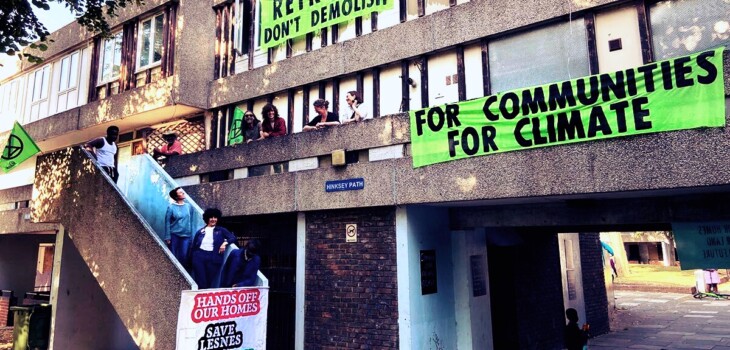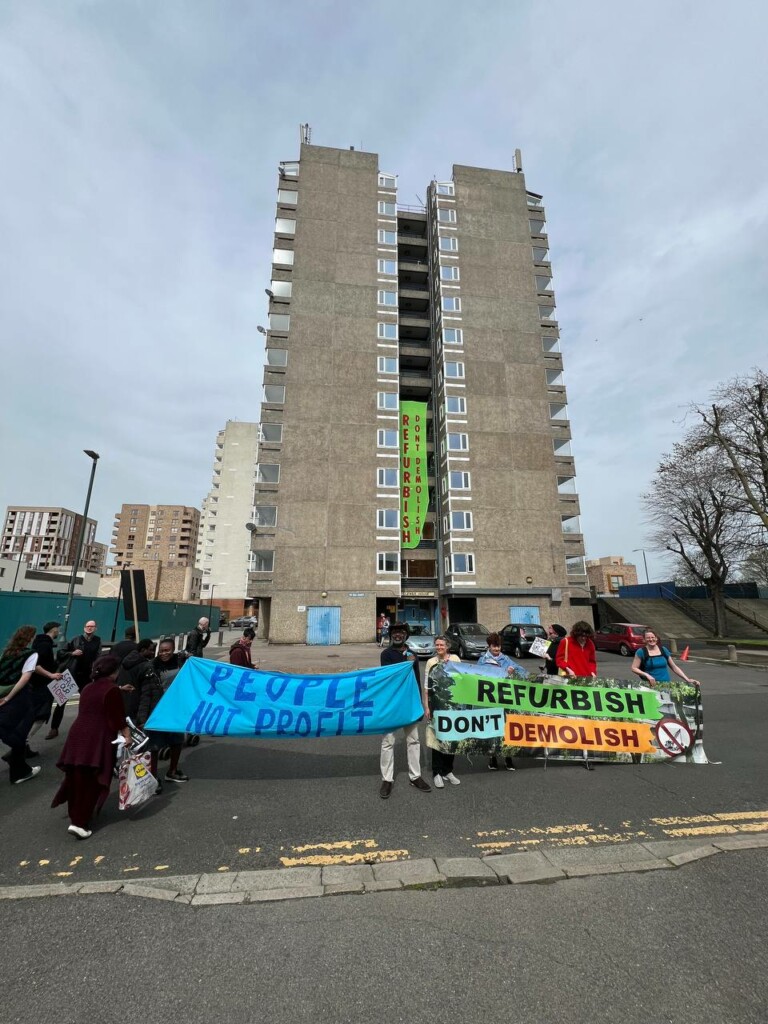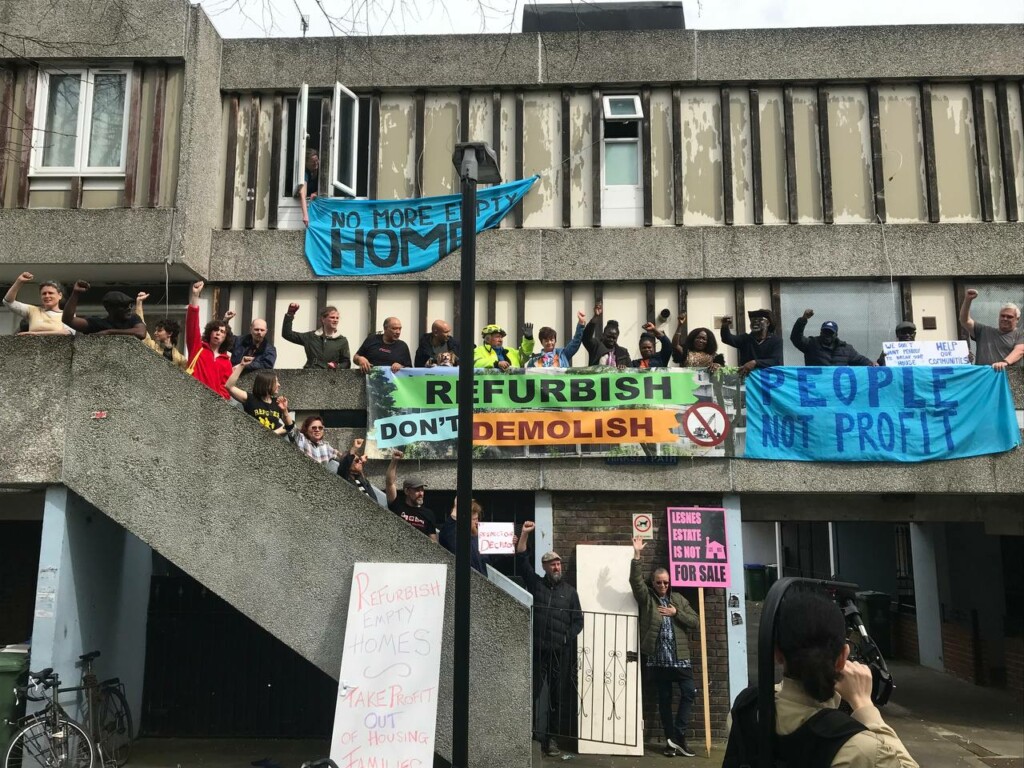Refurbish don’t demolish: the fight for the future of Thamesmead

Residents of Thamesmead, one of London’s largest and most iconic housing estates, are resisting housing association Peabody Group’s faltering plans to demolish their homes by advancing retrofit alternatives
Thamesmead, in south-east London, was built in the late 1960s by the GLC (Greater London Council) to house the many families who were made homeless by the so-called ‘slum clearances’ of south-east London. It is now once again a battleground against social cleansing, this time, one that goes by the name of ‘regeneration’. The stark neoliberal reality that imposes the demolition of affordable homes and their replacement with more expensive (and lucrative) luxury flats and amenities is justified by insisting that there is no alternative. But this is countered by the residents of Thamesmead themselves. In the course of authoring a report on the proposed redevelopment of Lesnes Estate in South Thamesmead, Corporate Watch spoke to residents fighting back against Peabody’s attempts to demolish their homes and learned about their compelling case for refurbishment instead.
A project of destitution and homelessness – Dr Johnnel Olabhie
Dr Johnnel Olabhie’s ordeal began nearly a decade ago when Peabody bid to buy the home he has owned for twenty years. The offer came with threats – it wanted to demolish Johnnel’s home and was prepared to use a compulsory purchase order to force through the sale.
This was no idle threat; with £12.7bn of assets, a turnover of £1.1bn, 4k employees, 107k properties and 220k tenants Peabody is one of the biggest landlords in the UK. It became the largest landowner in Thamesmead in 2014 through one of a series of mergers and acquisitions that have seen it grow rapidly, almost doubling in size since Corporate Watch profiled it in 2018. Olabhie was facing a battle against a corporate property empire that is also a ‘charitable Community Benefit Society’. He tried writing to Peabody to raise his concerns but all efforts to communicate this way proved futile. Turning to his neighbours, Olabhie discovered that they were in the same position: confused, stressed, concerned for their futures and unhappy at being told to expect demolition before they’d been consulted or plans had even been submitted. He called a meeting in his house in 2017 and together they formed the Abbey Wood Homeowners Association.
Not all residents are homeowners like Olabhie; the community also comprises social tenants, a handful of renters at market rates and guardians (short-term renters of vacant properties ensuring they do not get offered to people on the council housing waiting list). Of the 596 properties on the current Lesnes Estate, 411 were for social or affordable rent with 173 freehold and leasehold. One of the key strengths of the campaign that started in Olabhie’s house was the bringing together of all the Lesnes residents.
In 2017, they submitted a set of demands; they would not seek any estate agent evaluations and they would not consider equity or shared ownership with Peabody. They also objected to the replacement of low-income tenants with wealthier residents paying higher rents.

Lesnes resident’s Refurbish Don’t Demolish campaign Saturday April 6th 2024. Photo credit: Housing Rebellion
Peabody tries to divide and conquer
Whilst the community tried to make itself heard, Peabody pressed on with its ambitions to bulldoze their homes. It began a consultation process which ended in a ballot. Residents felt this was a sham, seemingly crafted to give Peabody its desired mandate. In 2020 residents’ right to expression was limited to a yes/no vote on a pre-set offer that did not reflect their demands, provided no alternative options and was so lacking in detail and clarity it didn’t even mention demolition. Voting was restricted to homeowners, social tenants and private renters on the council waiting list. Other private renters and guardians were excluded. Of those who could vote, only 65% participated, with homeowners either voting against or boycotting the process. The outcome – a 70% vote to proceed – was achieved by offering the best deal on paper to the majority – social tenants – including a cash incentive, the prospect of a quick turnaround and a promise of like-for-like homes.
Tenants were moved into recently completed properties from the earlier phase of the regeneration. Sadly, social tenants found that their new homes were not like-for-like. For one resident the new flat is hard to come to terms with. He does not like the new layout, which is open plan. There is no storage space and so on moving, he had to get rid of some belongings and pay to store others. It also costs more to live in. When it comes to heating and hot water bills, reducing usage makes little difference to the amount tenants pay, as the system is communal. Peabody is increasing rents over a ten-year period, but tenants don’t know by how much. He often looks out at his old flat, which he can see from his window. He would have preferred to stay living there.
A lack of affordable housing
The 70% vote to proceed was a blow for the residents campaigning to oppose the redevelopment. Peabody advanced plans to demolish nearly 800 homes on Lesnes and Coralline Walk and build up to 1,950 mainly luxury properties in their place. Despite the drastic increase in density there was to be a reduction of homes with ‘affordable rent’, down from 547 to 368 with only 61 of that total offering lower, genuinely affordable, social rent. Meanwhile, freehold homeowners now faced getting locked into unfavourable leasehold deals which risked huge debts or being forced to move out of the area as they were made to trade in their current homes for much more expensive ones. But new allies were around the corner.
From as early as 2015, Peabody had been placing guardians in empty properties on the estate. This type of residency is used to plug gaps in occupancy; as social tenants get moved on, guardians come in so that homes are not available on council housing waiting lists. This appeared to suit Peabody well; it could squeeze a little more revenue from the properties in the run-up to demolition without being encumbered by tenant’s rights.
Attempts to artwash social cleansing backfire
Bringing in guardians also helped Peabody put a cultural spin on the regeneration project. Partnering with Bow Arts, a company with charitable status, Peabody could claim that they were creating an artistic community and cultural hub in the area. The relationship with Peabody has proven lucrative for Bow Arts; now the proud owner of a 26,000 sq ft building with 70 studios near Bromley-by-Bow.
These members, the guardians, are the most precarious of all Thamesmead residents. They have the fewest rights as tenants and are forced to deal with a more complex hierarchy including the company they pay rent to, their ultimate landlord Peabody, and a string of maintenance contractors. As soon as they moved on to the estate in 2019, the artists toiled to make their homes habitable whilst paying Bow Arts rent and a ‘voluntary’ contribution of £150 per month. Several artists told Corporate Watch that most guardians were left with no choice as they were told that without paying it, Bow would not commit to providing help with maintenance issues.
The guardian’s experiences got even worse as Peabody ramped up what artists we spoke to described as “an active lack of maintenance and neglect” and the so-called ‘voiding’ of flats in the six tower blocks on Lesnes. Voiding sees homes gutted, rendered uninhabitable and boarded up, it is one of the final steps on the march towards demolition. We were told that the estate was being subjected to a ‘deliberate run down’ as part of a “concerted plan” to “drive people out”. Peabody contractors were stripping out the flats with no regard for residents. Dani, an artist and guardian, was forced to endure leaks in 2023 as a result of damage done by the voiding contractors. As water seeped across the living room floor, in close proximity to the fusebox, they felt unsafe and were left with no choice but to shut off the power. Trying to get anyone to take responsibility for repairs was a Kafkaesque ordeal in a Bermuda triangle of unaccountability between Bow Arts, Peabody and its contractors.
Exasperated, Dani decided to leave and served their notice. On the last day, Bow Arts offered a move to an adjacent block. Not prepared to face making yet another flat fit for habitation amidst the ongoing chaos of the voiding process, Dani reluctantly left.
But many artist guardians remain and are vital, engaged members of the community and creative contributors to the campaign of resistance to demolition. The homeowners, guardians and remaining tenants are now organising themselves into a tenants and residents association (TRA).

Lesnes residents and campaigners at the protest occupation of one of the estate’s many empty buildings on Saturday April 6th 2024. Photo credit: Housing Rebellion
Resident resistance builds momentum
The past year has seen other escalations by the collective of residents in their fight to refurbish rather than demolish the estate. In July 2023, there was a national, community day of action for ‘Housing for Need not Greed’ organised with the Radical Housing Network which led to a multi-day occupation of one of the many voided homes. In October, the residents called on London Mayor Sadiq Khan to intervene in their favour, securing the support of Greater London Authority (GLA) assembly member Siân Berry. You can watch Olabhie’s rallying call during the protest here.
The growing strength of the resident campaign contrasts with Peabody’s inertia as the project has been beset by major delays. Bexley Council approved the outline application for Lesnes Estate in late 2022. Whilst construction work was meant to have already begun in early 2024, the plans are currently awaiting the London Mayor’s decision and subsequent, more detailed applications would need to be submitted by Peabody for approval thereafter. There is the prospect of future legal challenges to decisions via judicial review and the possibility of a public inquiry into efforts to CPO homeowners.
A major contention with current plans is the paucity of affordable housing planned for delivery. Peabody is only proposing to build 35% affordable housing on the site, with just 61 available for the most affordable social rent, 307 at the more expensive “London affordable rent” and 279 shared ownership homes. It justified this by claiming it was going to make a £35m loss on the development. Despite Bexley Council’s own investigation projecting profits of £98m, it accepted a target far lower than the 50% both it and the GLA stipulate for developments involving demolition on the basis that Peabody would not be able to hit its self-imposed £110m profit benchmark.
There is an alternative – the case for retrofitting
Residents have seized the initiative and are pushing ahead with a feasibility study and bold retrofit plans in collaboration with AAB architects. Refurbishing the properties would mean residents could keep their homes and see them improved to bring them up to date and make them more energy efficient. They have a weight of precedent and evidence onside. In 2012, the South Thamesmead Regeneration Framework took a positive stance on refurbishment and labelled the area a potential total retrofit neighbourhood. Many properties on Lesnes have already had improvements, like triple glazing and new insulation, in recent years and adjacent parts of Thamesmead are earmarked for preservation through retrofitting. Avoiding demolition limits the release of embodied carbon in the existing buildings. Even the Mayor’s London Plan Guidance says it should be prioritised before demolition. Olabhie and the other residents campaigning to save their homes want to reverse Peabody’s dismissal of the retrofit option for Lesnes.
A fresh round of direct action was initiated on the first weekend of April 2024, with another protest occupation of an empty property, workshops and collaborations with other campaigns fermenting. The fight for the future of Thamesmead could help other residents and tenants facing similar battles up and down the country as developers tear down homes and scatter communities in the name of profits. If properly maintained and successfully retrofitted, these homes have a lot of life in them yet. Let’s hope they manage to stop history repeating itself, and that this time people aren’t forced out of perfectly viable homes in the name of so-called regeneration. For the Lesnes residents, as for many others living in similar estates, the true goal seems to be landlord profit.
Download a copy of the report here: Corporate Watch Lesnes Estate Development
